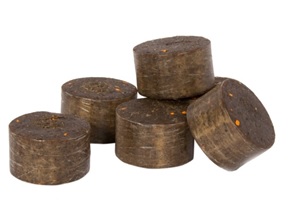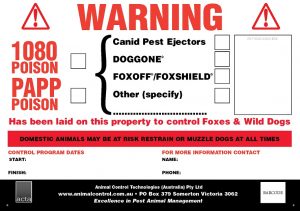If you suspect or know that your dog or cat has eaten a poison bait, you must contact your nearest veterinarian IMMEDIATELY. Do not delay action or wait for your pet to exhibit symptoms. If they have eaten a PAPP bait, the antidote MUST be given within 30-45 minutes of bait ingestion in order for your pet to have a reasonable chance of complete recovery.
PAPP (para-aminopropiophenone) is a new toxin for the control of wild dogs and foxes in rural and peri-urban areas. Likewise, it is toxic to domestic dogs and cats. An antidote is available, but it has some potential side effects and must be administered by a veterinarian very soon after bait ingestion.
Until now, 1080 (sodium fluroacetate) has been the main poison used in baits for the control of wild dogs and foxes. 1080 is also fatal to domestic dogs and cats and there is no antidote.
If poisoning is suspected, induced vomiting may help to reduce the amount of toxin absorbed by the gut (but you must still take your pet to your nearest veterinary practitioner as soon as possible). Your veterinarian will be able to advise you how to do this safely. However, if you have it available, placing 2-3 washing soda crystals on the back of the tongue should cause vomiting. If your pet vomits, look for bright yellow marker beads – these are contained within every manufactured PAPP bait, to assist with poisoning diagnosis. Conversely, manufactured 1080 baits contain red marker beads.
There are few initial signs of toxicity with PAPP poisoning. Affected animals first become tired, then lose coordination and lie down. Unfortunately, once these signs are obvious, there is a very small window of time for the antidote to be effective, as death usually occurs 1-2 hours later without treatment. Pet owners also need to be aware that there is a risk that the antidote may cause toxicity, however best practice treatment recommendations available to veterinarians for antidote administration should minimise the risk of accidental overdose.
If the antidote is given before the toxic effects of PAPP have progressed too far, it should provide almost immediate and complete recovery. Most veterinary practitioners will not stock methylene blue unless they are aware that PAPP baiting is being undertaken locally. If you are aware that PAPP baits are being used, it is advisable to alert your local veterinarian so that they can obtain the antidote.
The best protection from accidental poisoning is to prevent access to baits by containing pets indoors and ensuring if dogs are walked during baiting operations that they remain on a leash, are walked in non-baiting areas and are prevented from digging up and ingesting suspect baits. Private land holders and government authorities will also display large signage when baiting programs are undertaken – so look out for these signs and avoid these areas.
The baits are a round disc shape, are approximately 40mm long and dark brown in colour with a mottled appearance (as pictured below – Dogabait®).

Image 1: Dogabait® PAPP baits
Image supplied by Animal Control Technologies Australia
Bait warning signs (as pictured) must be displayed by landholders who participate in baiting programs and they must also notify immediate neighbours.

Image 2: Poison bait sign for both PAPP & 1080
Image supplied by Animal Control Technologies Australia
See also this article on the PestSmart website:
Baiting of wild dogs with para-aminopropiophenone (PAPP)
For veterinarians see the following article on the AVA website:
